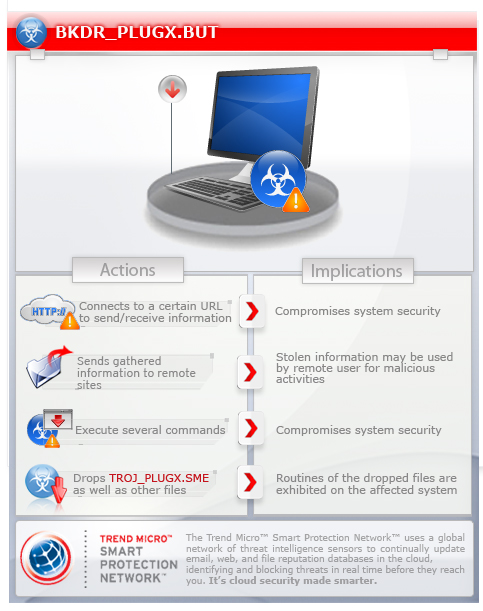BKDR_PLUGX.BUT
Windows 2000, Windows XP, Windows Server 2003


Threat Type: Backdoor
Destructiveness: No
Encrypted: Yes
In the wild: Yes
OVERVIEW
This malware is a remote access tool (RAT) known as PlugX. It is one of the most common malware used in carrying out targeted attacks. The targeted attacks it has been involved in are mostly directed towards government institutions in Japan.
To get a one-glance comprehensive view of the behavior of this Backdoor, refer to the Threat Diagram shown below.

This backdoor may be dropped by other malware.
It executes commands from a remote malicious user, effectively compromising the affected system.
It logs a user's keystrokes to steal information.
TECHNICAL DETAILS
Arrival Details
This backdoor may be dropped by the following malware:
- BKDR_PLUGX.SME
Installation
This backdoor drops the following files:
- All Users' %User Profile%\Gf\boot.ldr - detected as TROJ_PLUGX.SME
- All Users' %User Profile%\Gf\NvSmart.exe - a legitimate NVIDIA (NVIDIA Smart Maximise Helper Host)
- All Users' %User Profile%\SxS\bug.log - malware's error logs
(Note: %User Profile% is the current user's profile folder, which is usually C:\Windows\Profiles\{user name} on Windows 98 and ME, C:\WINNT\Profiles\{user name} on Windows NT, and C:\Documents and Settings\{user name} on Windows 2000, XP, and Server 2003.)
It drops the following copies of itself into the affected system:
- All Users' %User Profile%\Gf\NvSmartMax.dll
(Note: %User Profile% is the current user's profile folder, which is usually C:\Windows\Profiles\{user name} on Windows 98 and ME, C:\WINNT\Profiles\{user name} on Windows NT, and C:\Documents and Settings\{user name} on Windows 2000, XP, and Server 2003.)
It creates the following folders:
- All Users' %User Profile%\Gf
- All Users' %User Profile%\SxS
(Note: %User Profile% is the current user's profile folder, which is usually C:\Windows\Profiles\{user name} on Windows 98 and ME, C:\WINNT\Profiles\{user name} on Windows NT, and C:\Documents and Settings\{user name} on Windows 2000, XP, and Server 2003.)
It injects itself into the following processes as part of its memory residency routine:
- svchost.exe
Autostart Technique
This backdoor registers its dropped component as a system service to ensure its automatic execution at every system startup. It does this by creating the following registry entries:
HKEY_LOCAL_MACHINE\SYSTEM\CurrentControlSet\
Services\Gf
Description = "Gf"
HKEY_LOCAL_MACHINE\SYSTEM\CurrentControlSet\
Services\Gf
DisplayName = "Gf"
HKEY_LOCAL_MACHINE\SYSTEM\CurrentControlSet\
Services\Gf
ErrorControl = "0"
HKEY_LOCAL_MACHINE\SYSTEM\CurrentControlSet\
Services\Gf
ImagePath = ""All Users' %User Profile%\Gf\NvSmart.exe" 200 0"
HKEY_LOCAL_MACHINE\SYSTEM\CurrentControlSet\
Services\Gf
ObjectName = "LocalSystem"
HKEY_LOCAL_MACHINE\SYSTEM\CurrentControlSet\
Services\Gf
Start = "2"
HKEY_LOCAL_MACHINE\SYSTEM\CurrentControlSet\
Services\Gf
Type = "110"
Other System Modifications
This backdoor adds the following registry keys:
HKEY_LOCAL_MACHINE\SYSTEM\CurrentControlSet\
Services\Gf
HKEY_LOCAL_MACHINE\SYSTEM\CurrentControlSet\
Services\Gf\Enum
HKEY_LOCAL_MACHINE\SYSTEM\CurrentControlSet\
Services\Gf\Security
HKEY_LOCAL_MACHINE\SOFTWARE\Classes\
FAST
It adds the following registry entries:
HKEY_LOCAL_MACHINE\SOFTWARE\Classes\
FAST
CLSID = "{random hex values}"
Backdoor Routine
This backdoor executes the following commands from a remote malicious user:
- Copy, move, rename, delete files
- Create directories
- Create files
- Enumerate files
- Execute files
- Get drive information
- Get file information
- Open and modify files
- Log keystrokes and active window
- Enumerate TCP and UDP connections
- Enumerate network resources
- Set TCP connection state
- Lock workstation
- Log off user
- Restart/Reboot system
- Display a message box
- Perfrom port mapping
- Enumerate processes
- Get process information
- Terminate processes
- Enumerate registry keys
- Create registry keys
- Delete registry keys
- Copy registry keys
- Enumerate registry entries
- Modify registry entries
- Delete registry values
- Screen capture
- Delete services
- Enumerate services
- Get service information
- Modify services
- Start services
- Perform remote shell
- Connect to a database server and execute SQL statement
- Host Telnet server
It connects to the following URL(s) to send and receive commands from a remote malicious user:
- http://{BLOCKED}-save.{BLOCKED}d.com
- http://{BLOCKED}tdns.net
Information Theft
This backdoor logs a user's keystrokes to steal information.
Stolen Information
This backdoor saves the stolen information in the following file:
- {All Users' Profile}\Gf\kl.log
NOTES:
This backdoor is loaded each time the legitimate file NVSMART.EXE is executed.
The backdoor routines and C&C server this backdoor connects to depends on the contents of the loaded TROJ_PLUGX.SME.
SOLUTION
Step 1
For Windows XP and Windows Server 2003 users, before doing any scans, please make sure you disable System Restore to allow full scanning of your computer.
Step 4
Restart in Safe Mode
Step 5
Delete this registry key
Important: Editing the Windows Registry incorrectly can lead to irreversible system malfunction. Please do this step only if you know how or you can ask assistance from your system administrator. Else, check this Microsoft article first before modifying your computer's registry.
- In HKEY_LOCAL_MACHINE\SOFTWARE\Classes
- FAST
- FAST
- In HKEY_LOCAL_MACHINE\SYSTEM\CurrentControlSet\Services
- Gf
- Gf
Step 6
Search and delete these folders
- {All Users' Profile}\Gf
- {All Users' Profile}\SxS
Step 7
Restart in normal mode and scan your computer with your Trend Micro product for files detected as BKDR_PLUGX.BUT. If the detected files have already been cleaned, deleted, or quarantined by your Trend Micro product, no further step is required. You may opt to simply delete the quarantined files. Please check this Knowledge Base page for more information.
Did this description help? Tell us how we did.


